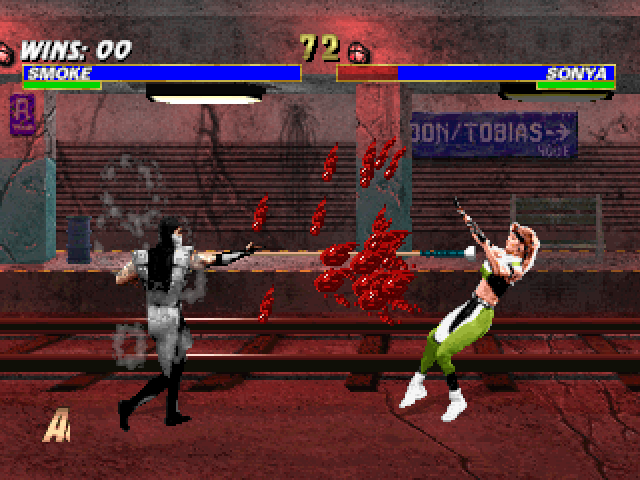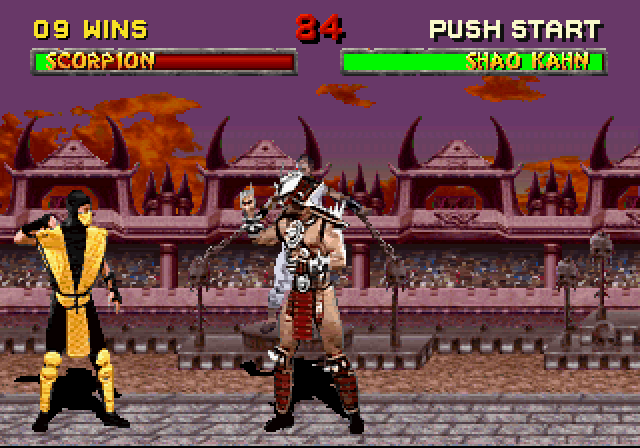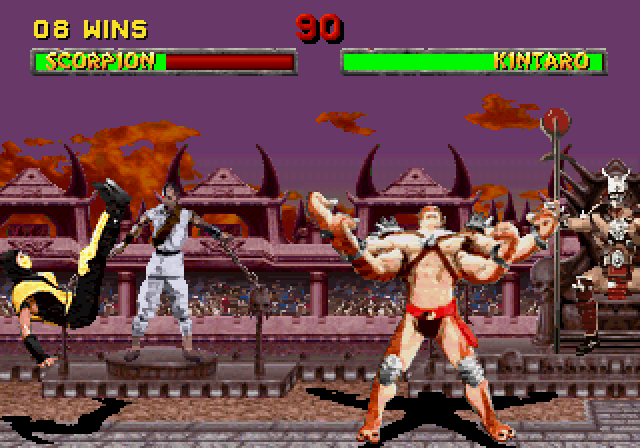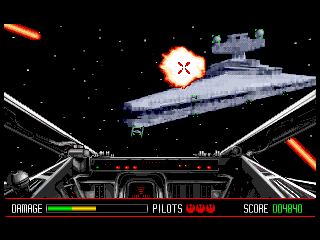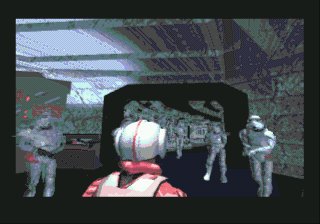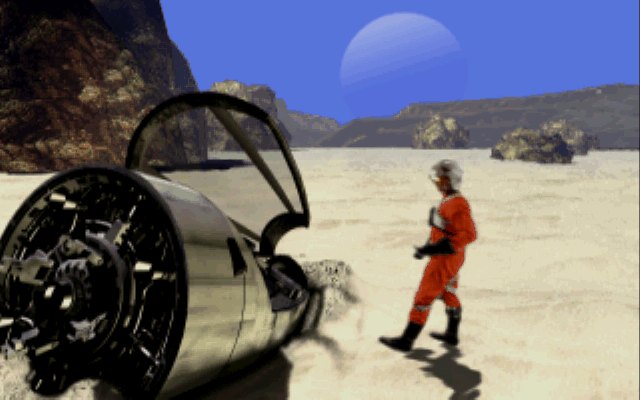When Mortal Kombat 3 became an arcade smash, the Midway creators
pulled a complete Street Fighter II; not only were there at least two
upgrades (for arcades and home consoles) but you couldn't swing a dead cat,
without seeing Mortal Kombat 3, Ultimate Mortal Kombat 3, or its final
version: Mortal Kombat Trilogy.
Following the exact same story as MK3, what sets Trilogy apart is
that it features all of the characters, and most of the arenas, from every
prior Mortal Kombat game. Yes, that includes all of the ninjas -- male
and female -- that were missing from the original MK3 but restored for Ultimate.
It also features a plethora of new moves, new finishers, and a new hidden
character (ONCE AGAIN, a ninja).
The graphics are pretty much like the port of MK3, except for the minor difference
that the warrior names are much more legible in the life bar (which were oddly
garbled in the MK3 port). A welcome improvement over the MK3 port, however, is
that you see far more of the incredible stages, from all of the classic games.
However, for a game that was released at the dawn of the Pentium era, it is
disappointing that the graphics are not at a higher resolution -- in fact, if
you were to play this in Windows 9x, the default display is a window about the
size of an audio cassette. Given that the previous games had no trouble being
in full-screen, and this one still plays fine at that setting, I don't
understand this decision.
One area where the graphics have a problem, in every version of the game,
has simply to do with the fact that several characters are ninjas. Now, I'm a
ninja fan, but it's really obvious that the ninjas in this game -- male or
female -- use exactly the same graphics as each other. The only difference,
aside from what special moves they use (sometimes) is merely the colour of
their outfit. So not only can it make for a bland visual experience, but there
are moments where one can't be blamed for wondering if they've popped in a
hyper-violent Power Rangers game, by mistake. This is especially so,
when the vast majority of the characters the game makes you fight against, are
ninjas, as opposed to the plethora of other characters.
Another graphics issue, has to do with the endings for each character. One
of my favourite parts of the series, is that when a player beats the game,
their epilogue is presented with unique and often cinematic artwork. However,
this game not only cheats with certain characters, by only showing a text crawl
over their versus portrait, but it confounds the issue by reusing the ending
pictures from the original MK3! Shit, or get off the pot, guys.
The audio... well, I can only comment so well. The sound effects are
exactly the same as MK3, so they're still intense and action-packed (even if
the game neglects to have a voice cue for Goro, for no apparent reason). The
music, however, I know absolutely nothing about; I've only played this through
abandonware downloads, which don't rip the music off of the CD-ROM, so I can
only guess that it was using the music from the arcade takes of the earlier
games.
The gameplay, is the single largest flaw in this game -- it is downright
horrible. This includes the absolutely absurd task of finding the control
mapping feature, AND getting it to configure the keys the way I'd wanted,
WITHOUT stepping on start/pause buttons that it never told me about, OR
overlapping with controls for the other player. I don't think I've ever
had that experience with a game, before.
Even once you get into the game itself, it's not exactly smooth sailing.
The AI fighters can be all over the place, in terms of difficulty -- one moment
the same opponent will be murdering you several rounds in a row, the next he
will suddenly be a punching bag. The two newest characters -- Noob Saibot and
Rain -- are so insanely overpowered that they can even beat bosses without
breaking a sweat (mind you that can come in handy, on the Champion ladder's
FIVE OPPONENT Super Endurance match). However, it's also way too easy to rely
on supermoves, when using them; the odd time you have to actually use your
hands and feet, you've almost forgotten what it was like. I'm also not
convinced that the hit detection works that well. Yes, that's right: in a
FIGHTING GAME, there's a fairly good chance that your attacks will go right
through an opponent, that is close enough for you to blow on.
It doesn't help, either, that the PC port of Trilogy is taken pretty
much bang-on, from the notoriously buggy Playstation version. While I can't
speak for how many of the glitches carry over from the Sony game to the PC one,
something that I have noticed is the odd tendency for fatality moves to not
work (even if you've used the correct command). This is especially obvious when
you've been beaten by retro characters who don't have Animalities, Brutalities,
or even second plain Fatalities... yet the computer still has them try to
perform those moves, meaning that the screen darkens and nothing else happens.
By the way, those goofy finisher names are not misprints, nor are they
practical jokes on my part. I'm not really sure what the thought process was,
but the silly finisher trend that started in MK2 with Friendships and
Babalities, added Animalities with MK3 (where the victor turns into an animal
-- for some reason -- and maims the opponent), and this game added Brutalities
(where the victor literally auto-combos the loser until they explode). On top
of being inappropriately absurd, for a game about people murdering each other
during a demonic invasion, it means that the vast majority of finishing moves
in this game, involve the loser being blown up -- once again, rather dull after
a while.
Probably the only saving grace, in terms of the gameplay, is that someone
had the sense to have a regular menu option, for the "dial-a-kombos"
to be fully automatic for the player. Believe me, between saving wear-and-tear,
and leveling the playing field a bit against the spitfire AI, this will do you
a huge favour.
Tips on beating the bosses, are pretty much the same as the previous games
(with the exception of Shang Tsung, since he appears as a standard character in
every variation of MK3). In other words, stay sharp, keeping moving, and take
advantage of any opening you can get. In fact, with Kintaro I would strongly
recommend fighting with Rain -- his control orb move is probably the fastest
projectile in the game, and if you don't let up he will fall for it every
single time. You're going to have to be more on guard, with Shao Kahn and
Motaro, simply because they each have new throw moves (and if you don't know,
those moves are unblockable). Considering that their offense is already
extremely high, this means you're in for an even rougher ride than in the
standard MK3. Then again, newly playable ninjas Rain and Noob Saibot are so
overpowered, that perhaps it balances out to a certain extent. It's a matter of
personal choice.
Personally, I'm not sure whether or not you should play this game or not.
With all three other PC versions of Mortal
Kombat being downloadable, these days, there's no real value to a semi-best
of edition that wasn't even that well made in the first place (despite the
developers having voice cues for "Outstanding",
"Excellent", etc. play over their logos in the intro sequence).
Actually, scratch that -- if you want to play MKT, download a Nintendo 64
emulator and play the version designed for that console (just because it's more
or less glitch free). Unless you want to be a completest (as of 1996), and
can't get the 2011 reboot game (which pretty much remakes this one), just skip
it in favour of the three individual games. Consign this abomination to the
pits of Outworld, where it belongs.
-8.jpg)
